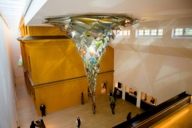
Munich has many locations which dazzle visitors with their unique lighting features, lighting designs and lighting moods. Here are just a few of them, from BMW to Westfriedhof.
When architects were planning the renovation of Lenbachhaus, they were faced with a challenge. On the one hand, the pieces on display needed to be lit as naturally as possible; at the same time, there was a need for variable coloured lights to provide the curators with as many design options as possible. The solution? LED lamps developed especially for Lenbachhaus. They provide unique, flicker-free lighting in each exhibition room. The lights were supplied by Munich-based lighting company Osram, while lighting artist Dietmar Tanterl was a consultant for the project.
The city’s most unassuming light installation adorns the outside wall of a school in the Maxvorstadt district – many residents don’t even know it’s there, as it remains in darkness for more than 23 hours of every day. Between 9.20 and 9.21 pm daily, it bursts into life, gradually illuminating in red to commemorate Georg Elser; a member of the resistance against the Nazi regime, who once lived just a few doors down the road. In 1939, he used a homemade bomb to attempt to kill Adolf Hitler in a beer cellar. It exploded at 9.20 pm, destroying the hall and killing eight of the dictator’s supporters, though Hitler himself survived – that night he had broken with routine and gone home early. Elser was arrested, and executed in Dachau concentration camp shortly before the end of the war.
No other U-Bahn station in Munich has managed to combine light and darkness to such successful effect. Disembarking here, you would be forgiven for initially assuming the train had pulled into a cave: the walls of the high platform area are made of untreated rock. The only light comes from eleven enormous hemispherical lamps that grow from the ceiling, casting various shades of blue, red and yellow onto the length of the platform. The idea originated with Munich's famous light artist Ingo Maurer, who died in October 2019 at the age of 87. Maurer also designed the lighting concept for Münchner Freiheit U-Bahn station and the mezzanine level at Marienplatz station.
1.2 kilometres: that’s the length of Munich's longest light installation, the Lightway. Or, as artist Keith Sonnier also calls it: Lichtbad (Light bath). Sonnier is a pioneer in the lighting world, and the brains behind this installation. His work is the first or the last piece of art seen by travellers in Munich, as it winds through a wide tunnel under the airport. Passengers can use various conveyor belts to travel quickly between one area of the airport and the next, and as they do, a trail of fluorescent lights accompanies them on their route, changing colour in rhythm, switching primarily between red and blue. The light creates an ambience which allows passengers to forget the stress of travel for a moment. Sonnier spent three years completing his installation.
BMW Welt is always lit up. During the day, sunlight reflects off its large glass façade, and when the sun goes down, spotlights beam onto the “Tornado”: a vortex made completely from glass, flanking the main entrance to BMW Welt. Yellow and blue lights light up in alternation. On the other side of the road, the impressive BMW eight-cylinder tower looms up from the ground, housing the vehicle manufacturer's headquarters. The top and bottom levels of the cylinders are normally lit up. If you climb nearby Olympiaberg (Olympic Mountain), you can see even more, as the Allianz Arena beyond the BMW premises glows red through the night, while Munich’s city centre lights up in the other direction. This spot is a magnet for night photographers.
All of Munich's landmarks are illuminated at night but the Friedensengel is particularly striking. It is considered to be one of the city’s most beautiful illuminations, visible from far and wide and a popular spot for sightseeing. From the illuminated terraces below the Friedensengel, you can enjoy great views over the Lehel and Maxvorstadt neighbourhoods at night – a panorama that you could even call romantic. Which means it will be no surprise to learn that it's a popular location for proposals. The landmark was built in several stages between 1891 and 1899, in honour of the peace agreement following the Franco-German War of 1870/71. The column is 23 metres tall, and the angel's wings span around five metres from tip to tip.